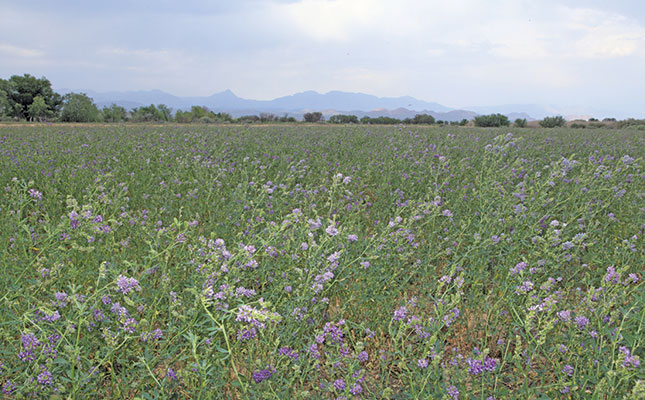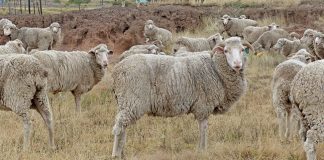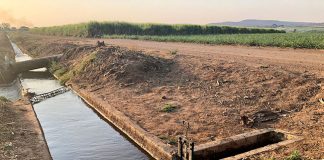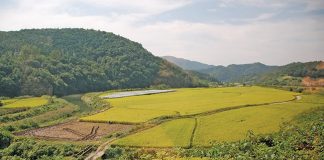
Photo: Glenneis Kriel
Around the world, a growing number of farmers are switching to crop rotation due to its capacity to improve farm earnings through higher yield and reduced fertiliser, pesticide and herbicide usage, while boosting sustainability.
Long-term rotation trials by the Western Cape Department of Agriculture at the Langgewens Research Farm in the Swartland and Tygerhoek in the Southern Cape confirm this.
In crop rotation evaluations that started at Langgewens in 1996, wheat monoculture has always been the poorest performer of all the combinations under trial.
But in rotations that included at least one type of legume, such as lupines or medics, the average wheat yield was 30% higher than when wheat was produced in a monoculture. The yields of rotations containing no legumes were on average 12% higher.
Best rotation
A medic-canola-medic- wheat rotation consistently performed the best, producing an average yield 37% better than a system where wheat was produced on its own.
Water- and nitrogen-use efficiency also improved. Water-use efficiency of rotations that included canola was 11% higher, and rotations that included one or more years of legume crops or pastures were between 26% and 31,6% higher than when wheat was planted on its own.
Nitrogen-use efficiency was on average 89% better in rotations that included legumes than when wheat was produced alone, and 35% better when the rotation included only one year of legumes.
The use of canola in the rotation, without any legumes, increased nitrogen-use efficiency by 9%.
During the past two seasons, of which 2017 was dry and 2018 had below-average rainfall, the researchers set out to establish how low the nitrogen level could be reduced in a medic and wheat rotation.
In 2017, wheat was planted with only 12kg/ ha of nitrogen. In 2018, this was reduced to 9kg/ha. During both years, a top dressing of 30kg/ ha of nitrogen was applied.
The evaluation revealed that in 84% of the trial camps, half of them produced higher yields when less nitrogen was used.
The rotations also helped to make systems more resilient and drought-resistant.
According to Dr Johann Strauss, a sustainable cropping system scientist at the Western Cape Department of Agriculture, wheat yields averaged approximately 500kg/ ha on the farm during the 2003 drought, but averaged around 2,1t/ ha during the 2015 drought and 2,4t/ha during the 2017 drought, described by many as one of the worst experienced in the Swartland.
Strauss explains that the use of crop rotation helps to boost yield by improving soil health and structure, breaking disease cycles and giving farmers an opportunity to better manage weed problems.
But, he warns, it is no silver bullet, and must be used as part of a conservation farming system. In other words, it should be used in conjunction with reduced tillage, stubble retention and/or cover crops.
The livestock factor
Including animals in the system also has a number of advantages, according to Strauss. Animals add significant value to rotations that include legume pastures, such as lucerne and medics, by enabling the crops to pay their way on the farm while diversifying farm risks.
“Cover crops are obviously not the same as a feed mix you buy from the shop, but can help to significantly reduce feed costs,” says Strauss.
Although some farmers are not in favour of animals grazing their lands as they fear this may lead to compaction, trials at Langgewens show that it is better to have animals graze pastures than to make hay from these pastures. This is because grazing leaves more plant material behind.
“You need to leave at least 30% to 50% of the plant material to get the best results out of your conservation farming efforts,” notes Strauss.
Animals may also help to reduce weed problems and recycle cover crop nutrients when grazing pastures.
Cattle are generally easier to run than sheep, as they can graze cover crops at a later stage.
Intercropping
The international push for more eco-friendly farming systems that restore natural ecosystem services has resulted in a growing awareness of the importance of biodiversity above and below the ground, and its importance for farm sustainability, says Strauss.
This, in turn, has led to the promotion of concepts such as intercropping, where two crops such as peas and canola are planted in alternating rows, giving a farmer the opportunity to earn income from two crops rather than one.
Companion cropping is another useful practice. Here, two crops are planted, the first being the cash crop and the other playing a supportive role. The combination of maize and clover is an example of this.
Ideally, however, at least three crops should be rotated, says Strauss.
The choice of crops and the manner in which they are incorporated in a rotation will depend on production goals as well as production conditions.
Regenerative agriculture
The Western Cape Department of Agriculture this year started trials on regenerative agriculture at its Tygerhoek Research Farm near Riviersonderend.
“In my opinion, regenerative farming is a more refined version of conservation farming, with the primary aim being to restore the soil so that all ecosystem services are in full working order. Livestock forms an integral part of the system,” says Strauss.
The general philosophy behind the approach is that healthy soils equal healthy roots and plants, with healthy plants being less susceptible to pests and diseases.
Regenerative agriculture has produced good results on various farms across the world, with US farmers reportedly being able to produce the same crop with little to no input costs.
The trial at Tygerhoek was launched to determine whether this production approach would be viable for South African farmers, specifically in the Western Cape.
“The trial will include winter and summer cover crops, high- intensity grazing, cash crops, pollinator strips and even honey production,” says Strauss.
“We’ve also introduced biochar on half of each of the lands that form part of the trial to try to build soil carbon as quickly as possible.
“The idea is to produce cash crops with no artificial inputs within three seasons.”
Email Dr Johann Strauss at [email protected].











